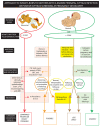Congenital Syphilis-An Illustrative Review
- PMID: 37628309
- PMCID: PMC10453258
- DOI: 10.3390/children10081310
Congenital Syphilis-An Illustrative Review
Abstract
Congenital syphilis is caused by the spirochete, Treponema pallidum, which can be transmitted from an infected mother to her fetus during pregnancy or by contact with a maternal lesion at the time of delivery. The incidence of congenital syphilis is rapidly increasing all over world with 700,000 to 1.5 million cases reported annually between 2016 and 2023. Despite the widespread availability of Penicillin, 2677 cases were reported in 2021 in the US. Clinical manifestations at birth can vary widely ranging from asymptomatic infection to stillbirth or neonatal death. Low birth weight, rash, hepatosplenomegaly, osteolytic bone lesions, pseudoparalysis, central nervous system infection, and long-term disabilities have been reported in newborns with congenital syphilis. Prevention of congenital syphilis is multifaceted and involves routine antenatal screening, timely treatment of perinatal syphilis with penicillin, partner tracing and treatment, and health education programs emphasizing safe sex practices and strategies to curb illicit drug use. Neonatal management includes risk stratification based on maternal syphilis history, evaluation (nontreponemal testing, complete blood counts, cerebrospinal fluid, and long-bone analysis), treatment with penicillin, and followup treponemal testing. Public health measures that enhance early detection during pregnancy and treatment with penicillin, especially in high-risk mothers, are urgently needed to prevent future cases of congenital syphilis.
Keywords: congenital syphilis; hydrops; syphilis; treponema pallidum; vertical transmission.
Conflict of interest statement
The authors declare no conflict of interest. The funders had no role in the design of the study; in the collection, analyses, or interpretation of data; in the writing of the manuscript; or in the decision to publish the results.
Figures




References
-
- Paixao E.S., Ferreira A.J., Dos Santos I.O., Rodrigues L.C., Fiaccone R., Salvi L., de Oliveira G.L., Santana J.G., Cardoso A.M., Teles C., et al. Mortality in children under 5 years of age with congenital syphilis in Brazil: A nationwide cohort study. PLoS Med. 2023;20:e1004209. doi: 10.1371/journal.pmed.1004209. - DOI - PMC - PubMed

